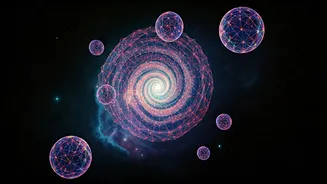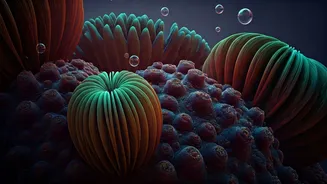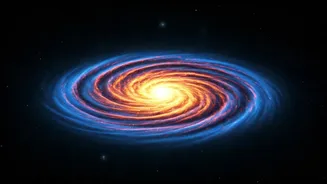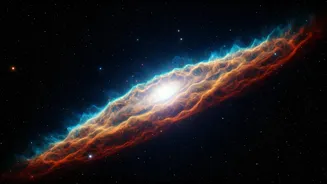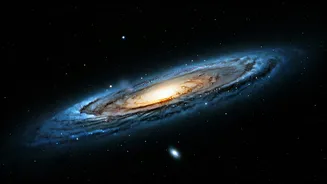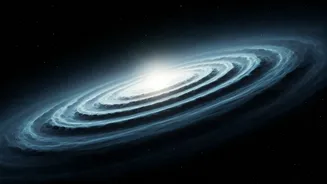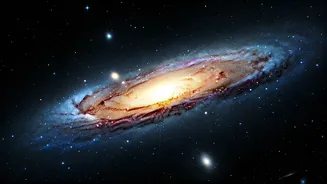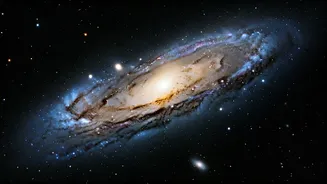Quantum Weirdness Unveiled
Let's begin with the truly mind-bending realm of quantum mechanics, where the rules of the everyday world don't apply. One fascinating fact is quantum entanglement,
where two particles become linked in such a way that they share the same fate, no matter how far apart they are. If you measure the property of one particle, you instantly know the corresponding property of the other, even if they're light-years away! Another head-scratcher is quantum superposition, where a particle can exist in multiple states simultaneously until measured. Imagine a coin spinning in the air: it's both heads and tails until it lands. This principle challenges our classical understanding of cause and effect, suggesting that reality isn't as concrete as we perceive it to be. These phenomena, although difficult to grasp, are at the heart of quantum computing and other cutting-edge technologies.
The Fabric of Space
Our next exploration delves into the vastness of space and the surprising things it holds. Firstly, did you know that space itself isn't entirely empty? It's filled with dark matter and dark energy, which together make up about 95% of the universe's content, and are invisible to us. Scientists are still trying to figure out exactly what these mysterious components are! Then, consider the concept of time dilation. According to Einstein's theory of relativity, time passes differently depending on your speed and the strength of gravity. This means that a person in orbit experiences time slightly differently than someone on Earth. The faster you move or the stronger the gravitational pull, the slower time passes relative to a stationary observer. This seemingly abstract concept has real-world implications, even affecting the accuracy of GPS satellites.
Amazing Animal Oddities
The animal kingdom is full of strange and wonderful creatures, each with their own unique adaptations. Consider the immortal jellyfish, scientifically known as Turritopsis dohrnii. This remarkable species can revert to a polyp state after reaching sexual maturity, effectively becoming young again. While not truly 'immortal' in every sense, this cycle allows them to potentially live forever, barring predators or disease. Then, let's look at the electric eel. Capable of generating powerful electric shocks, these eels use this ability for hunting and defense. A single eel can produce up to 600 volts, enough to stun prey or ward off threats. Finally, the bombardier beetle has a defense mechanism that is truly explosive. When threatened, it mixes chemicals within its body to create a boiling, noxious spray, directed at the predator. These extraordinary adaptations demonstrate the remarkable diversity and ingenuity of life on Earth.
Body's Strange Wonders
Our own bodies are equally full of surprises. One odd fact is that the human body glows! We emit a tiny amount of light, too faint to be seen with the naked eye, a byproduct of biochemical reactions. Furthermore, the human stomach produces hydrochloric acid, which can dissolve metal. However, the stomach lining is protected by a layer of mucus to prevent self-digestion. Another unexpected fact involves the gut microbiome, which contains trillions of microorganisms that significantly influence our health, from digestion and immunity to even our mood and behaviour. These tiny inhabitants play a crucial role in our wellbeing, highlighting the complex relationship we have with the unseen world within us.
Physics-Defying Facts
Delving into physics uncovers some of the most mind-blowing concepts. Consider the Casimir effect, which demonstrates that empty space is not actually empty. Even in a vacuum, quantum fluctuations create a pressure that can attract or repel objects depending on their placement. Also, there's the strange fact about sound: sound waves can actually travel through solids, liquids, and gases, but they can't travel in a vacuum. Sound travels by the vibration of particles, and there are no particles in a vacuum. Finally, the concept of entropy. This fundamental law states that everything in the universe tends towards disorder. Systems naturally move from order to disorder, and energy is constantly being dissipated. This means everything eventually breaks down, which has large implications for understanding the future of the universe.
Geological Anomalies Explored
The Earth itself presents numerous mysteries. Did you know that the Earth's magnetic field is constantly shifting, and the poles periodically reverse? This reversal can impact technology and navigation. Also, we can't forget the extreme pressures and temperatures deep inside our planet. The core is hotter than the surface of the sun! Furthermore, the existence of supervolcanoes, like Yellowstone, show that earth has periods of instability. The forces that shape our planet continue to generate surprises, from earthquakes to volcanic eruptions. Understanding this dynamic environment is a key factor in comprehending our world's past and future.
Space's Astonishing Secrets
Continuing our journey beyond Earth, let's explore some captivating facts about our universe. The observable universe is expanding at an accelerating rate. Scientists attribute this to dark energy, the mysterious force that is pushing galaxies further apart. Then, the immense black holes that lurk in galaxies, including our own Milky Way, have an event horizon, the point beyond which nothing, not even light, can escape. Furthermore, the sheer scale of the universe is staggering. The Milky Way galaxy alone contains billions of stars, and there are billions of galaxies in the observable universe. This vastness is truly mind-boggling, sparking imagination and challenging our perception.
Chemical Conundrums Revealed
Chemistry, like all sciences, has its oddities. Consider the properties of water. It expands when frozen. This is why ice floats, as it is less dense than liquid water, a rare property for materials. Also, there are materials that can change their properties under extreme conditions. For instance, carbon can form both diamond and graphite, each with unique structures and behaviours. Moreover, some chemical reactions occur so quickly, they seem instant. Others take ages. From the arrangement of atoms to the energy that binds them, the world of chemistry is a fascinating and unexpected frontier.
Mind-Bending Biological Facts
The biological world constantly amazes. One example of this is the sheer complexity of the human brain. It contains about 86 billion neurons, each connected to thousands of others, creating a network of unimaginable complexity. Also, there are the remarkable regeneration abilities of some creatures, such as the axolotl, a type of salamander that can regrow limbs, spinal cords, and even parts of its brain. This ability has scientists intrigued. Furthermore, the role of DNA is pivotal. It contains all the instructions for building and maintaining an organism. Its structure reveals the secrets of heredity and evolution. The biological world is a continuous source of wonder, showing the intricate dance of life.
Final Thoughts: Awe-Inspiring
These 20 facts provide a glimpse into the bizarre, counterintuitive, and astonishing nature of the universe and everything in it. From the depths of the quantum world to the vastness of space and the intricacies of life on Earth, science continuously reveals new wonders. These examples encourage us to consider our understanding of reality, inspiring curiosity and a thirst for knowledge. The more we learn, the more we realize how much we have yet to discover, and the more we appreciate the beauty and complexity of our existence.
